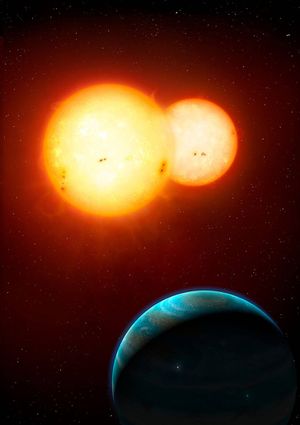No edit summary |
No edit summary |
||
| (3 intermediate revisions by the same user not shown) | |||
| Line 1: | Line 1: | ||
[[File:xj-765-022719.jpg|thumb]] | [[File:xj-765-022719.jpg|thumb]] | ||
This star system was found on the other side of the [[Janus Gate]] traveling to the universe designated as [[ | This star system was found on the other side of the [[Janus Gate]] traveling to the universe designated as [[Darkian Churarius Reality]]. The universe itself is fairly distant from the source location of what has been dubbed the ''Prime Universe'' where Janus Gate sits. | ||
The system is a binary star with two stars orbiting equal-distance from each other in a state of gravitational balance. They orbit around a pair of central focal points which compose a region of intense electromagnetic interference and subspace energy. The two stars are similar to that of Earth's own sun. Star ''Alpha'' is a G3V while the ''Beta'' star is slightly smaller, a G1V. Alpha is about 1.5 times the size of Sol (Earth's sun) while the other is about 0.9 times the size of size of Sol. | The system is a binary star with two stars orbiting equal-distance from each other in a state of gravitational balance. They orbit around a pair of central focal points which compose a region of intense electromagnetic interference and subspace energy. The two stars are similar to that of Earth's own sun. Star ''Alpha'' is a G3V while the ''Beta'' star is slightly smaller, a G1V. Alpha is about 1.5 times the size of Sol (Earth's sun) while the other is about 0.9 times the size of size of Sol. | ||
| Line 24: | Line 24: | ||
Since the moons of these are so small relative to the planet themselves, it is possible they contain Naquadah as well but that it was not detected. | Since the moons of these are so small relative to the planet themselves, it is possible they contain Naquadah as well but that it was not detected. | ||
[[Category:Star Systems]] | [[Category:Darkian Churarius Star Systems]] | ||
[[Category:Vamelos Sector]] | |||
Latest revision as of 07:04, 24 December 2021

This star system was found on the other side of the Janus Gate traveling to the universe designated as Darkian Churarius Reality. The universe itself is fairly distant from the source location of what has been dubbed the Prime Universe where Janus Gate sits.
The system is a binary star with two stars orbiting equal-distance from each other in a state of gravitational balance. They orbit around a pair of central focal points which compose a region of intense electromagnetic interference and subspace energy. The two stars are similar to that of Earth's own sun. Star Alpha is a G3V while the Beta star is slightly smaller, a G1V. Alpha is about 1.5 times the size of Sol (Earth's sun) while the other is about 0.9 times the size of size of Sol.
Discovery
The 6th probe launch into this universe was tasked with identifying possible habitable planets or existing civilizations. It was programmed with a course to examine 12 different star systems that previous probes had detected had potential M-Class planets and instructed to make a more focused survey of possible M-Class planets within the target systems.
Features
The star system has a number of interesting features, the core out to 2 AU from the center is composed of an unusually dense asteroid field and dust cloud, similar to what one might find in a stellar remnant nebula. At the edge of that cloud is its first planet, 719-Prime, which is very Earth-like in size and composition. Scans indicate that the planet has an Oxygen-Nitrogen atmosphere and that it fits well within the Class M designation. It has 3 moons, 2 about a quarter of the size of Earth's moon and one about twice as large.
Scans indicate that the planet may have intelligent life, but due to the extreme magnetic interference from the dust cloud and the binary stars themselves, it was impossible to get a clear reading.
Beyond that, there are 12 other planets in the system. The outermost 7 are gas giants, each with its own complex moon system.
Solid Planets
Planets 1 through 5 are solid rocky planets. The first, as discussed, is a Class M world. The 2nd, 3rd, and 4th planets fit into the Class C range, while the 5th planet is Class P.
Unusual energy readings from the 5th planet in the system indicate that it may have Naquadah, the element used in the production of the Stargates. The energy signature fits the subspace spectral readings expected for a large amount of the element.
Gas Giants
The rest of the planets in the system are standard gas giants, though usually a system does not have this many. Each of the gas giants has its own extensive system of small moons. The planets themselves are standard hydrogen-helium composition atmospheres along with an estimated mass of 10-20% of the atmosphere likely being methane, ammonia, argon, and ice. Further detailed scans will be necessary to better understand the exact makeup of each.
Since the moons of these are so small relative to the planet themselves, it is possible they contain Naquadah as well but that it was not detected.